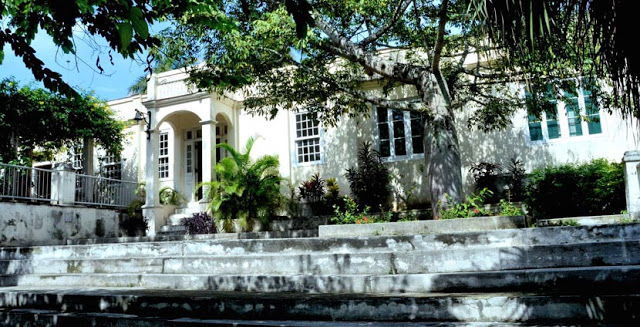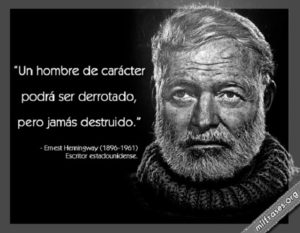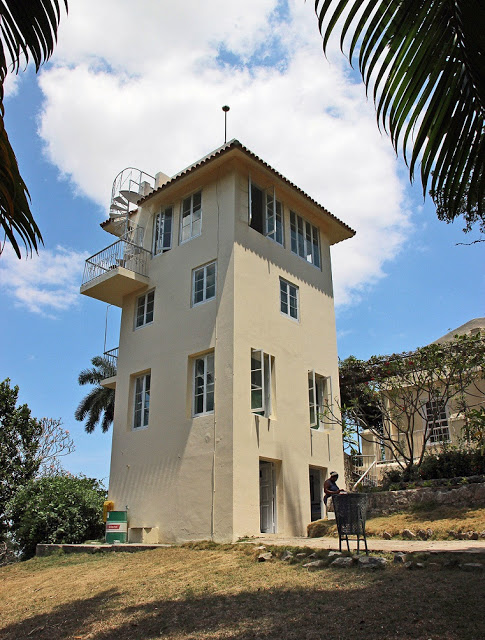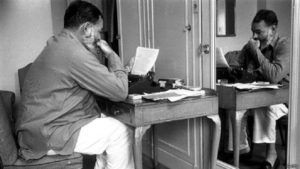Gabriel García Márquez said of him that no foreign writer, much less an American, had left so many traces “on his way through the less thoughtful places” of Cuba.
Hemingway came to Havana for the first time in 1928, and that meeting left some mark because a short time later he began to explore the Gulf Stream in search of places to satisfy his love of fishing, and in one of those incursions he met Gregorio Fuentes , patron of the Pilar yacht, his means of transport in the adventures of the Cuban seas.
Ernest Hemingway fell in love with Cuba at first sight. Although his need to travel was insatiable, the American lived in Cuba for 25 years.
The Ambos Mundos Hotel in Old Havana was the first place that Hemingway had as a home in Cuba. Ali lived, from 1932, for almost nine years intermittently and in room 511 he wrote one of his best novels, “For whom the bell tolls”. The hotel opened in 1925, preserves the account that the American had in the bar and the iconic room 511 is today a museum, Hemingway is still there. The panoramic view of the city from there was not only a delight for his eyes, but the subject of several chronicles, including the first one he wrote about Cuba, published in 1933 in the Esquire magazine.
He also describes the Havanan wonders in his only play, “The Fifth Column”, written in 1938, in which one of his characters says: “(…) and have you ever been to the Sans Souci in Havana, a Saturday night to dance in the courtyard under the royal palms (…)? ”
But his real home in Havana was Finca Vigía, which he bought in 18,500 dollars in 1940 with the rights he won for the edition of “For whom the bell tolls”. “I always had good luck writing in Cuba,” he said in a letter to a friend. “Where a man feels at home, apart from where he was born, that is the place he was meant to be,” Hemingway once wrote.
THE FARM ‘LA VIGIA’.
After his departure from Paris in 1928, Hemingway never lived in a big city again.
Havana is cooler than most cities in the northern hemisphere in these months, because the trade winds blow from 10 in the morning to four or five the next day. Ernest Hemingway, August 1934.
It is his third wife, the writer and war correspondent, Martha Gellhorn, who encourages him to settle in Finca Vigía in the early 40s. In 1937 the two lived a romance that would end with his separation from Pauline, but his relationship with Martha He had a second breath in Cuba, exactly in that country house that would be his real home for 20 years.
But a few years later, during World War II, Hemingway traveled to Europe again as a correspondent. He was in the D-Day landing in Normandy and in the liberation of Paris and fell in love with the journalist Mary Welsh, with whom he married for the fourth time, reason why Finca Vigía had a new owner.
It must be said that the previous owner of Finca Vigía had it closed and did not allow anyone’s access, but Hemingway first opened the gate of that place to anyone who needed something from him or from there.
He forbade the cutting of a tree or any other type of plant, and never again killed a bird and there the mangoes, guavas and other types of fruits were for the enjoyment of the boys of the neighborhood, and even allowed the people of San Francisco went in to take them, or the gardeners were ordered to take them out to the door so that anyone who wanted to could be served.
But as a good American he had rules, such as not throwing stones at trees or climbing on them and of course not interrupting him at the time he wrote. He built a baseball field and bought a team of gloves, bats, balls and other accessories for the boys he had seen playing around on improvised grounds. And practicing tennis, boxing and using the pool was also free for the boys, unless they had guests.
In November 1956, while in Paris, he remembered the trunks that he had stored in the Hotel Ritz in 1928 and that he had never recovered. The trunks were full of notebooks and writings of his years in Paris. When he returned to Cuba in 1957, enthusiastic about the discovery, he began to write what can be considered autobiographical, a semblance of the good times he lived in his youth, “Paris was a party”, he extended “Al break the dawn”, added chapters to “The Garden of Eden” and worked on “Islands in the Gulf”, where he mentions the codes to decipher the key messages he sent from the Pilar yacht during the adventurous operation of pursuit of Nazi submarines that he starred in the northern keys of Cuba during the Second World War.
Hemingway had spent three years working on stories and a novel, when on a trip from Paris to Switzerland, his first wife, Hadley Richardson, suffered the theft of luggage when leaving the wagon to buy water. Of them only two stories fortunately sent to a magazine survived. Hemingway, many years later would realize that the fact had had its positive side and is that the director of the Ritz Hotel in Paris saved him and returned two suitcases full of papers that he had left when Paris was a party.
However, the writer had to leave Finca Vigía in July 1960, a year and a half after the triumph of the Revolution, due to the tense diplomatic relations between the Government of Washington and the Cuban government. Unfortunately those years were very dark in the life of the writer who plunged into depression and alcoholism and ended up committing suicide, a year after leaving Cuba, in 1961. But there remains in ‘Finca Vigía’ his mark.
ERNEST HEMINGWAY EN SU DESCUBRIMIENTO DE CUBA.
Gabriel García Márquez dijo de él que ningún escritor extranjero, mucho menos un estadounidense, había dejado tantas huellas “a su paso por los sitios menos pensados” de Cuba.
Hemingway vino por primera vez a La Habana en 1928, y ese encuentro dejó alguna huella pues poco tiempo después comenzó a explorar la corriente del Golfo en busca de parajes para satisfacer su afición por la pesca, y en una de esas incursiones conoció a Gregorio Fuentes, patrón del yate Pilar, su medio de transporte en las aventuras por los mares cubanos.
Ernest Hemingway se enamoró de Cuba a primera vista. Aunque su necesidad de viajar fue insaciable, el norteamericano vivió en Cuba durante 25 años.
El Hotel Ambos Mundos en La Habana Vieja fue el primer lugar que Hemingway tuvo como hogar en Cuba. Alí vivió, a partir de 1932, durante casi nueve años de forma intermitente y en la habitación 511 escribió una de sus mejores novelas, “Por quién doblan las campanas”. El hotel inaugurado en 1925, conserva la cuenta que el norteamericano tenía en el bar y la icónica habitación 511 es hoy un museo, Hemingway aún sigue ahí. La panorámica que desde allí tenía de la ciudad no solo fue deleite para su vista, sino tema de varias crónicas, entre ellas la primera que escribiría sobre Cuba, publicada en el año 1933 en la revista Esquire.
También describe las maravillas habaneras en su única obra de teatro, “La quinta columna”, escritas en 1938,en la que uno de sus personajes dice: “(…) ¿y has estado alguna vez en el Sans Souci de La Habana, un sábado por la noche para bailar en el patio bajo las palmas reales (…)?”.
Pero su verdadero hogar en la Habana fue Finca Vigía, la que compró en 18.500 dólares en 1940 con los derechos que ganó por la edición de “Por quién doblan las campanas”. “Yo siempre tuve buena suerte escribiendo en Cuba”, afirmó en una carta a un amigo. “Donde un hombre se siente como en su casa, aparte del lugar donde nació, ése es el sitio al que estaba destinado”, escribió en una ocasión Hemingway.
LA FINCA ‘LA VIGIA’.
Después de su salida de París en 1928, Hemingway nunca volvió a vivir en una gran ciudad.
La Habana es más fresca que la mayoría de las ciudades del hemisferio septentrional en estos meses, porque los alisios soplan desde las 10 de la mañana hasta las cuatro o las cinco del siguiente día. Ernest Hemingway, agosto de 1934.
Es su tercera esposa, la escritora y corresponsal de guerra, Martha Gellhorn, quien lo anima a instalarse en Finca Vigía a principios de los años 40. En 1937 los dos vivieron un romance que terminaría con su separación de Pauline, pero su relación con Martha tuvo un segundo aliento en Cuba, exactamente en esa casa campestre que sería su verdadero hogar por 20 años.
Pero pocos años después, durante la Segunda Guerra Mundial, Hemingway viajó a Europa otra vez como corresponsal. Estuvo en el desembarco del Día D en Normandía y en la liberación de París y se enamoró de la periodista Mary Welsh, con la que se casó por cuarta ocasión, por lo que Finca Vigía tuvo una nueva dueña.
Hay que decir que el anterior dueño de Finca Vigía, la tenía cerrada y no permitía el acceso de nadie, pero Hemingway lo primero que hizo fue abrir el portón de aquel lugar a todo el que necesitara algo de él o de allí.
Prohibió que se cortara un árbol ni otro tipo de planta, y nunca más se mató un pajarito y allí los mangos, guayabas y otros tipos de frutas eran para el disfrute de los muchachos de la vecindad, y hasta se permitía que las personas de San Francisco entraran a cogerlas, o se ordenaba a los jardineros que las sacaran a la puerta para que pudiera servirse todo el que quisiera.
Pero como buen americano tenía reglas, tales como no tirar piedras a los árboles ni subirse a ellos y por supuesto no interrumpirlo en las horas en que escribía. Construyó un campo de béisbol y compró un equipo de guantes, bates, pelotas y otros accesorios para los muchachos que había visto jugando en los alrededores en terrenos improvisados. Y el practicar tenis, boxeo y usar la piscina era también libre para los muchachos, a no ser que tuviera invitados.
En noviembre de 1956, estando en París, se acordó de los baúles que había almacenado en el Hotel Ritz en 1928 y que nunca había recuperado. Los baúles estaban llenos de cuadernos y escrituras de sus años en París. Cuando regresó a Cuba en 1957, entusiasmado con el descubrimiento, comenzó a escribir la que puede considerarse autobiográfica, una semblanza de los buenos tiempos que vivió en su juventud, “París era una fiesta”, extendió “Al romper el alba”, añadió capítulos a “El Jardín del Edén” y trabajó en “Islas en el golfo”, donde menciona los códigos para descifrar los mensajes en clave que enviaba desde el yate Pilar durante la aventurera operación de persecución de submarinos nazis que protagonizó en los cayos del norte de Cuba durante la Segunda Guerra Mundial.
Hemingway llevaba tres años trabajando en cuentos y en una novela, cuando en un viaje de París a Suiza, su primera esposa, Hadley Richardson, sufrió el hurto del equipaje al abandonar el vagón para comprar agua. De ellos solamente sobrevivieron dos relatos enviados afortunadamente a una revista. Hemingway, muchos años después se daría cuenta que el hecho había tenido su parte positiva y es que el director del Hotel Ritz de París le guardó y devolvió dos maletas repletas de papeles que había dejado cuando París era una fiesta.
Sin embargo, el escritor tuvo que dejar Finca Vigía en julio de 1960, un año y medio después del triunfo de la Revolución, debido a las tensas relaciones diplomáticas entre el Gobierno de Washington y el cubano. Por desgracia esos años fueron muy oscuros en la vida del escritor que se sumergió en la depresión y el alcoholismo y acabó suicidándose, un año después de salir de Cuba, en 1961. Pero allí en Finca Vigía sigue vigente su huella.
Agencies/Memorias Cubanas/Carlos Rodríguez/Internet Photos/ Arnoldo Varona/ TheCubanHistory.com
THE CUBAN HISTORY, HOLLYWOOD.











